Black pepper history. Black Pepper: From Ancient Luxury to Modern Kitchen Staple – A Spicy Journey Through Time
How did black pepper become the world’s most popular spice. What role did it play in shaping world history. Why was pepper once considered “black gold”. Discover the fascinating story behind this everyday seasoning.
The Origins of Black Pepper: A Fruit with a Spicy Legacy
Black pepper, scientifically known as Piper nigrum, has a rich history dating back over 4,000 years. Despite its ubiquity in modern kitchens, few people realize that pepper is actually a fruit. How can this be? Botanically speaking, any plant that bears seeds is classified as a fruit, and pepper certainly fits this criterion.
The pepper plant is a climbing vine native to the lush tropical regions of southern India, particularly around the city of Kerala. It belongs to the Piperaceae family, known for producing small, berry-like fruits that, when dried, become the familiar peppercorns we use to season our food.
Ancient Roots and Royal Connections
The earliest documented mentions of pepper date back to ancient Indian writings from around 2000 BCE. Perhaps even more intriguingly, peppercorns were discovered in the nasal cavities of the Egyptian Pharaoh Ramses II during his mummification process. This discovery provides tangible evidence of pepper’s value and use in ancient civilizations.

How did pepper spread beyond its native India? Trade routes, both overland and maritime, played a crucial role in disseminating this prized spice throughout the ancient world. By the time of the Roman Empire, pepper had become well-known and highly sought after in the Mediterranean region.
The Pepper Price: When Spice Was Worth Its Weight in Gold
In the ancient world, pepper commanded astronomical prices, earning it the moniker “black gold.” But just how expensive was it? According to the Roman historian Pliny the Elder, writing in the 1st century CE, long pepper fetched 15 denarii per pound, white pepper 7 denarii, and black pepper 4 denarii. To put this into perspective, the monthly salary of a Roman soldier at the time was approximately 30 denarii.
Why was pepper so incredibly valuable? Several factors contributed to its high price:
- Rarity and limited supply due to its distant origin
- Difficult and dangerous transportation routes
- High demand for its culinary and medicinal properties
- Its role as a status symbol among the wealthy
The term “pepper price” originated from this historical context, referring to any exorbitantly expensive item. This phrase has endured, even as pepper itself has become more affordable and accessible.

The Multifaceted Appeal of Black Pepper: More Than Just Flavor
While we primarily associate pepper with its culinary uses today, its historical popularity stemmed from a combination of factors. What made pepper so desirable throughout history?
Culinary Enhancements
First and foremost, pepper’s ability to enhance the flavor of food was a primary driver of its popularity. Its pungent, spicy kick could elevate even the blandest of dishes, making it an essential ingredient in ancient and medieval cookery. The Roman cookbook “De Re Coquinaria” from the 3rd century CE features pepper as a key component in nearly every recipe, highlighting its culinary importance.
Medicinal Applications
Beyond its taste, pepper was believed to possess numerous medicinal properties. What health benefits did ancient civilizations attribute to black pepper?
- Alleviating toothaches
- Treating constipation
- Combating insomnia
- Soothing sunburns
- Reducing gas and bloating
- Promoting urination and sweating to eliminate toxins
- Addressing respiratory problems
Modern research has confirmed some of these traditional uses, revealing that black pepper indeed possesses antibacterial and antioxidant properties. Some studies even suggest potential antitumor effects, though more research is needed in this area.

A Symbol of Prestige
In addition to its practical uses, pepper served as a powerful status symbol in ancient and medieval societies. Having pepper on one’s table was a clear indication of wealth and social standing. This prestige factor further drove up demand and prices for the spice.
Pepper’s Impact on World History: Spice Routes and Exploration
The immense demand for pepper in Europe had far-reaching consequences, shaping the course of world history in unexpected ways. How did this humble spice influence global events?
The Spice Trade and Economic Impact
The lucrative pepper trade became a driving force behind the development of complex trade networks connecting Asia, the Middle East, and Europe. Cities like Venice and Genoa rose to prominence as key intermediaries in this trade, amassing great wealth and power.
Exploration and Colonial Expansion
The desire to find new routes to the pepper-producing regions of India played a significant role in the Age of Exploration. Portuguese navigator Vasco da Gama’s successful voyage around Africa to India in 1498 was largely motivated by the search for a sea route to bypass existing overland spice routes controlled by Arab and Venetian merchants.

This quest for pepper and other spices ultimately led to the establishment of colonial empires, reshaping global power dynamics and ushering in a new era of international trade and cultural exchange.
From Luxury to Everyday Staple: The Democratization of Pepper
How did pepper transition from an ultra-expensive luxury to an affordable kitchen staple? Several factors contributed to this transformation:
- Improved transportation and trade routes
- Increased cultivation in various tropical regions
- Advancements in preservation and packaging techniques
- The rise of global commerce and mass production
By the 19th and 20th centuries, pepper had become widely available to the general population in many parts of the world. Today, it stands as the most commonly used spice globally, with an estimated annual consumption of over 400,000 tons.
The Science of Spice: Understanding Pepper’s Pungency
What gives black pepper its characteristic heat and flavor? The compound responsible is called piperine, an alkaloid that stimulates the trigeminal nerve endings in the mucous membranes of the nose and mouth. This stimulation creates the sensation of heat and pungency that we associate with pepper.
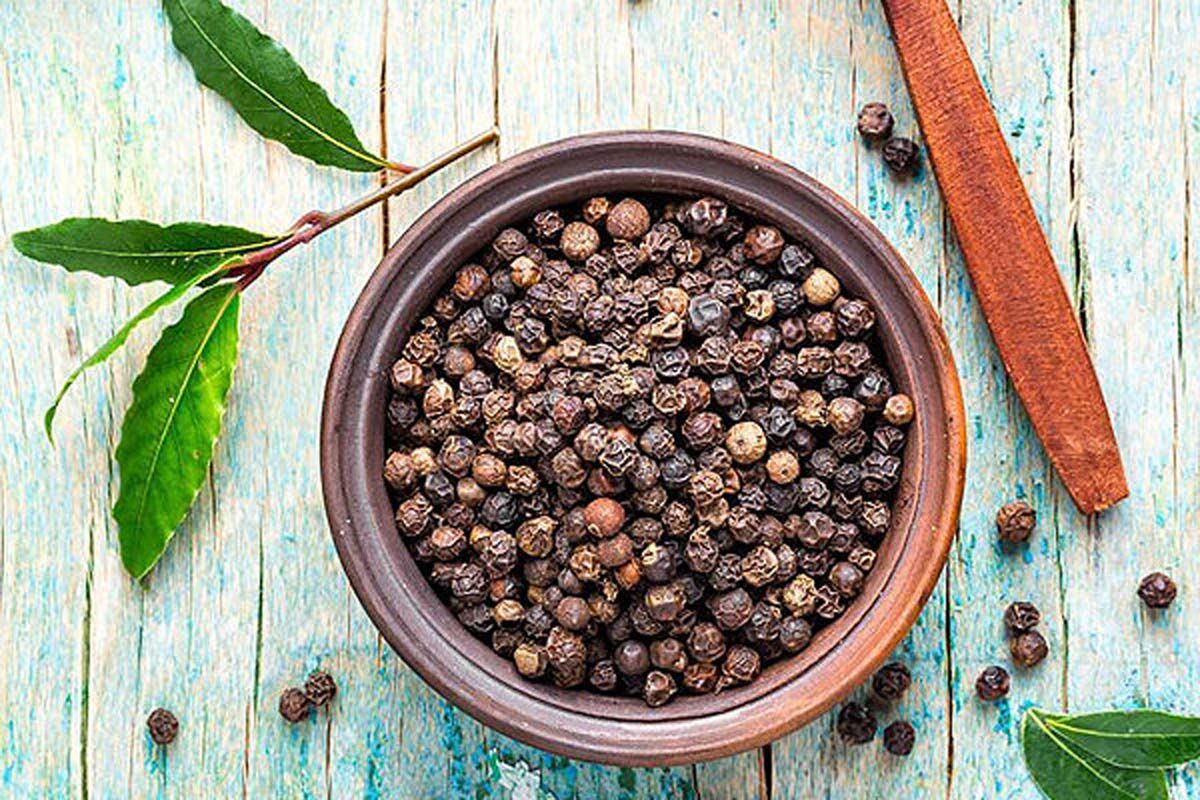
Types of Peppercorns
While black pepper is the most common variety, there are several other types of peppercorns, each with its own unique flavor profile:
- White pepper: Made from fully ripe pepper berries with the outer skin removed
- Green pepper: Unripe pepper berries that are quickly dried or preserved
- Red pepper: Fully ripe pepper berries, rarely found outside of their growing regions
- Pink peppercorns: Not true pepper, but berries from a different plant with a similar flavor
Modern Culinary Uses and Global Variations
How is black pepper used in contemporary cuisine around the world? Its applications are nearly endless, but some common uses include:
- As a table condiment for seasoning dishes to taste
- In spice blends and rubs for meats and vegetables
- As a key ingredient in sauces and marinades
- In baked goods for a subtle heat and complexity
- As a finishing touch on fresh fruits like strawberries or melon
Different cultures have incorporated pepper into their culinary traditions in unique ways. For example, in French cuisine, the classic steak au poivre features a crust of cracked black peppercorns. In Indian cooking, black pepper is often used in conjunction with other spices in complex masala blends.

Sustainability and Ethical Considerations in Pepper Production
As global demand for pepper continues to rise, what challenges does the industry face in terms of sustainability and ethical production?
Environmental Concerns
Pepper cultivation, like many forms of agriculture, can have significant environmental impacts. These may include:
- Deforestation to clear land for pepper plantations
- Soil degradation due to intensive farming practices
- Water pollution from pesticide and fertilizer runoff
- Loss of biodiversity in monoculture plantations
Fair Trade and Labor Practices
Ensuring fair compensation and safe working conditions for pepper farmers and laborers is an ongoing challenge. Some initiatives, such as Fair Trade certification, aim to address these issues by promoting ethical standards in spice production.
Sustainable Alternatives
What steps are being taken to make pepper production more sustainable? Some promising approaches include:
- Organic farming methods that avoid synthetic pesticides and fertilizers
- Agroforestry systems that integrate pepper vines with other crops and trees
- Water conservation techniques and improved irrigation systems
- Support for small-scale, diversified farming operations
As consumers become more conscious of the environmental and social impacts of their food choices, the pepper industry will likely continue to evolve towards more sustainable and ethical practices.

The journey of black pepper from an exotic luxury to a ubiquitous kitchen staple is a testament to its enduring appeal and versatility. From ancient trade routes to modern sustainability challenges, this humble spice has played a fascinating role in shaping human history and culture. As we sprinkle pepper on our meals today, we can appreciate the rich legacy behind this everyday seasoning and consider its continued importance in global cuisine and commerce.
Black Pepper History and Few Other Interesting Facts
Is a pepper a fruit? What are the benefits of black pepper? Where does black pepper come from? Have you ever wondered where the term pepper price came from? This is about black pepper history and how it became so used and popular in kitchens all over the world. This is a story of the plant and spice, but also of ancient civilisations, greed, wars, the discovery of America and other great explorations and, of course, cooking.
Black pepper is today an indispensable spice in every kitchen, what
makes it the most commonly used spice in the world. Some may argue that salt is
the most used condiment in the kitchen, but salt technically is not a spice,
but a mineral.
Food Advertisements by
However, pepper is only recently accessible and a cheap commodity
on the shelves of supermarkets. The history of pepper goes back 4000 years and
the demand for it has had a tremendous impact on the shaping of modern
civilization. Before the oil, the term “black gold” referred to the pepper.
Before the oil, the term “black gold” referred to the pepper.
Pepper originates from Southern India, around city Kerala. The
plant pepper (lat. Piper nigrum) belongs to climbing plants from the family
Piperaceae, that is grown for their fruit which gives spice – pepper. According to botanists, every plant
that has seeds is a fruit, so for this reason the pepper is considered a fruit.
The first records of pepper date back to 2000 years BC when it was
mentioned in ancient Indian writings, and peppercorns were found in the
nostrils of the pharaoh Ramses II. Pepper was well known to the ancient Romans,
so the Roman historian Plinius Elder wrote about pepper in his work on Natural
History from the first century AD. There is also a well-preserved cookbook from
the 3rd Century De Re Coguinaria, where pepper is an integral part of almost
every dish.
Pliny states the prices of pepper, but also writes that:
“Long pepper … is fifteen denarii per pound, while that of white pepper
is seven, and of black, four”, which is a quite high price for that time.
Let’s just say the soldier’s salary was around 30 denarii per month. However,
Pliny, fond of moralizing, raises another very important question:
“Pepper has nothing in it that can plead as a recommendation to
either fruit or berry, its only desirable quality being a certain pungency; and
yet it is for this that we import it all the way from India! Who was the first
to make trial of it as an article of food? And who, I wonder, was the man that
was not content to prepare himself by hunger only for the satisfying of a
greedy appetite?
Food Advertisements by
What makes pepper so desirable? What are the benefits of black pepper?
Answering this question is not easy, but we will try to explore it.
First, the most important reason why spices are used is to improve
the taste of food, but through history, spices also had a secondary purpose. Interesting
fact is, in the absence of a toothbrush and toothpaste, people used spices to
remove or at least reduce the bad breath.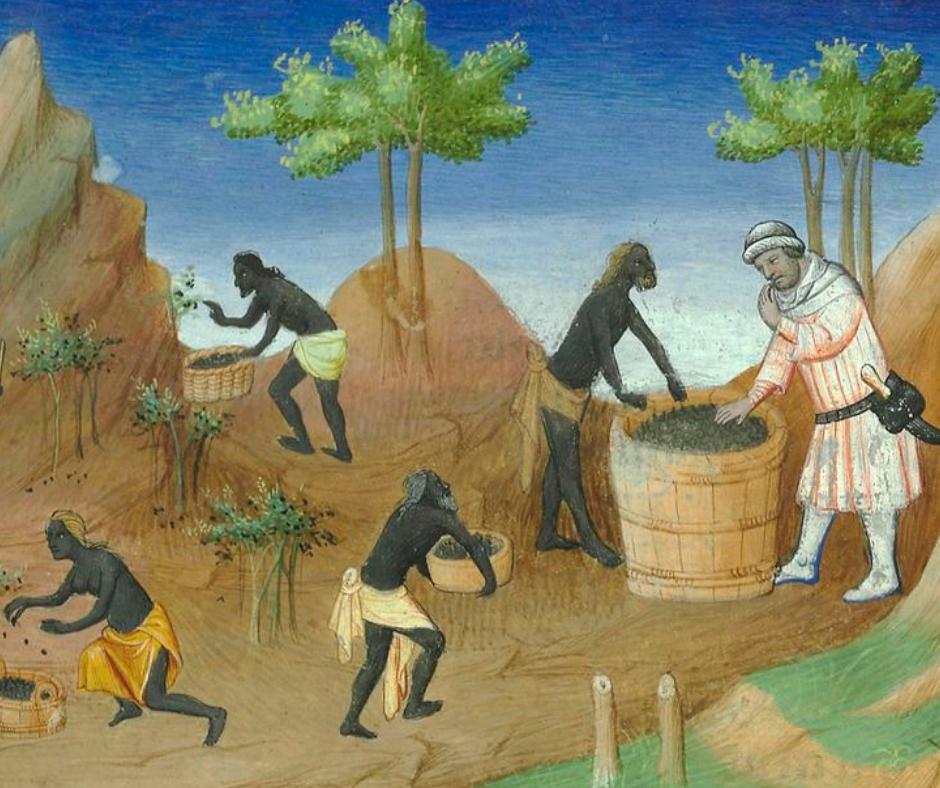 Pepper was very good for this purpose
Pepper was very good for this purpose
because, except for the strong flavour, it was believed that it had antiseptic
properties.
Here is another reason for the demand for pepper, medical. It was
believed that pepper helps with toothache, constipation, insomnia, sunburn and
many other illnesses.
In addition, pepper reduces the formation of gases, stimulates
urination and sweating to release toxins from the body.
Pepper is used to alleviate respiratory problems, and has antibacterial properties, but also has the potential as antioxidants. List of all health benefits from black pepper is long.
There are some researches which indicate
it has antitumor properties as well.
It is useful in losing weight, since the outer coat of peppercorn
positively affects the breakdown of fat cells in the body.
The third reason why the pepper was so desired and such an expensive
commodity is that it can significantly shape the human history is simple –
prestige. Having pepper on desk was a matter of prestige and show of wealth.
Having pepper on desk was a matter of prestige and show of wealth.
Thus, a pinch of pepper meant more delicious food, better
digestion, lack of bad breath, and also a better health and position in
society. Taking all this into consideration, it is clear why pepper was such a
desired commodity.
In Europe pepper demand has logically stimulated pepper trade, and
since it is grown in India, it has created a number of logistical problems,
resulting in a demand that is always higher than the supply, and hence a high
price. Pepper has thus become a synonym for a high price or – a pepper price. Hence, that term.
Peppercorn price hung up Alaric, King of the Visigoths, when he
besieged Rome. In exchange for dragging and not destroying the city, he sought
gold and silver from the Romans, but it is quite interesting, he did not forget
to add either 3000 pounds of pepper.
After Alaric, Rome did not last long and with the collapse of Rome
in 476AD, Europe was plunged into the Dark Ages. The spice trade moved
The spice trade moved
eastward, taken over by the Eastern Roman Empire known as Byzantium, and more so
by Islamic merchants.
After the fall of Rome, the spice market was completely disrupted,
and those who first exploited the opportunity was the small Italian cities –
Venice and Genoa. Skilful merchants from these cities joined Islamic ones and
began trading spices, mostly pepper. The Venetian Republic, one of the greats powers
of the Europe between the 14th and 16th centuries, emerged from this trade and
pepper contributed to this rise. According to some written records from that
time at the end of the 15th century, only merchants from Alexandria exported
400 tons of black pepper per year to Venice, and the Venetians earned a 40%
margin on it.
Constantinople, and therefore Byzantium, 1453 g. fell in the hands
of the new emerging power – the Ottoman Empire. By conquering the Arabian
Peninsula and Egypt, the Turks now controlled the entire spice trade from the
east. In addition to the conquest, the Turks had another disadvantage for
Europeans – they were excellent merchants and had a monopoly on pepper trade in
Europe, which meant – bigger price.
The Venetians continued to trade with the Turks, this time under
Turkish conditions. However, in other countries, adventurers have appeared
willing to challenge the position of Venice as the main spice importer and
trader. One such was Christopher Columbus. He managed to persuade the Spanish
royal couple Izabela I and Ferdinand II, to finance his journey to search East
India by sailing west. Columbus was one of the first who accepted the
Copernican realization that the earth is round, which at that time was very
bold, considering the then current Church teaching and preferences of religious
inquisition to burn down opponents.
In 1493 Columbus, with his three ships, went on a journey that
would later prove to be one of the most important in the history of mankind, as
he found a new continent – latterly known as America. However, Columbo was firm
in his belief that he had found the East coast of India. Due to this blunder,
the locals found there he called the Indians, and that name remained to them
today, even though they had absolutely no connection with India. However, this
However, this
was not the end of his self-esteem as he was in India. Among other things, he
found a new plant – chilli peppers, whose fruits were a bit like pepper, and
called it a red pepper. If you have noticed the similar etymological origin of
paprika and pepper in different languages, even though these two plants have no
similarity – it should also thank to Columbus. And now most interesting fact. Because
of his ignorance, the new continent he discovered was named America, by another
researcher Amerigo Vespucci, simply because he was the first to realise that this
was a new continent.
In any case, Spaniards had discovered a new continent, but neither
were the Portuguese were sitting idly. Vasco da Gamma only a few years later
circumnavigated the Africa and really came to India, as he said to the Sultan
who ruled there, in search for Christians and spices. It was the beginning of
the Portuguese dominance of the pepper trade. Thus, Portuguese king Manuel
himself has taken the right to have a monopoly over pepper trade, and therefore
French king Francois I called him “le roi épicier”, meaning “the
grocer king”. But the grocer king sold about 2 million pounds of pepper
But the grocer king sold about 2 million pounds of pepper
each year as it came from the Malabar coast and raised millions of cruzados.
And then the pepper had 70% of the total spice trade. Very hypocritical
statement Francois, given that he had a serious problem with his state treasury.
New founded trade routes solved the distribution problem, which is
why prices have fallen and pepper has become available to a somewhat larger
number of citizens. This was the time when pepper entered the regional and
national cuisine of almost all European countries, alongside then traditional
spices. At this time, well-known spice blends such as quatre in France, Cajun
and jerk blends in New World, garam masala in India, ras el hanout in Morocco,
and many others are being created.
During the 16th Century, Portugal and Spain, due to newly
discovered territories and trade routes, continued to build their colonial
empires. It did not go unnoticed by another state that has just ruled out the
Spanish occupation – the Netherlands. In order to finance travel and find new
In order to finance travel and find new
colonies and trade routes, the Netherlands have invented a new way of financing
– selling bonds and shares of stock to
the general public. This will later become known as the
first stock exchange. Although Italian cities knew the system of
transferable government bonds, it was not a stock exchange in today’s sense of
the word. The Dutch East India Company (VOC) was the first company in the world
to issue shares to capitalize, and with these shares it they were later traded
freely on a permanent market.
Later, the company became the first multinational company, in
today’s sense of the word, and the first company constantly listed on the stock
exchange. And at one point it was the most valuable company in the world.
Over time, the Netherlands pushed down the Portuguese and took control
of the shipping routes through which spices came into Europe. However, neither
their domination lasted for a long time, as another superpower became
interested in spice trade – the United Kingdom.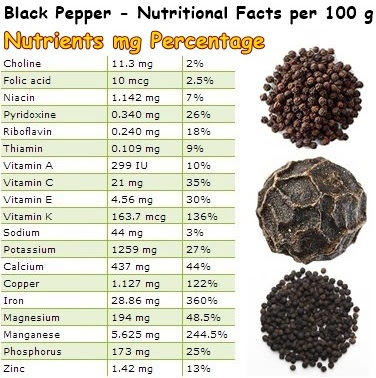 This lead to several wars
This lead to several wars
between the Dutch and the United Kingdom, which ultimately resulted in the
victory of the British, the takeover of trade routes and a bit later with
collapse of the Dutch East India Company.
The British have the merit of making pepper widely available,
improving the production and supply of pepper to Europe. Thanks to them, the
pepper will go out of history and will increasingly enter the cuisine.
Thus, during the 16th and 17th centuries as Pepper spread across
Europe and entered the kitchens of wider range of population. The pepper has
lost its prestige as a luxury good and suddenly it was not so prestigious to use
pepper. However, during the period of the Enlightenment in France in the 18th
century pepper was back in a big way. Francois Pierre de la Varenne, was the
first, let’s call it a celebrity chef in France, and in his works, he promoted
the use of pepper together with salt. His “invention” will be held to
this day, and this is certainly one of the proofs that the Enlightenment was
not only politically and scientifically oriented but brought some of the new
revolutionary ideas in the kitchen as well.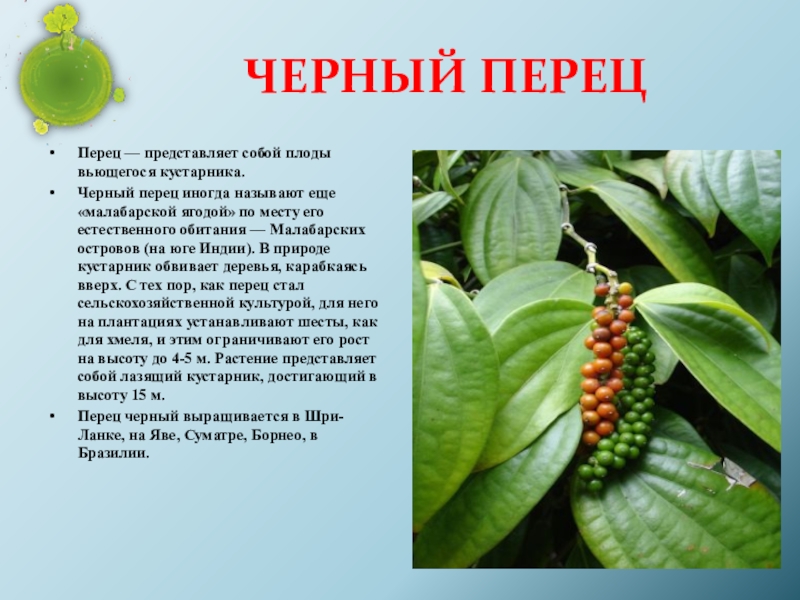
Today, pepper is the most widely used spice in the world, and it
is considered that 20% of the total spice trade is pepper. Production balance has shifted, so it is the world’s
largest producer of pepper is Vietnam. One more quite interesting fact, the
largest producers in the world with more than 1/3 of the world’s total
production, Vietnam exports virtually all the production, since the Vietnamese do
not use pepper in their diet. India is only in third place, even behind
Indonesia.
Unlike Vietnamese, the peoples of the United States are the
biggest pepper buyers. Over $ 650 million worth of pepper is being imported
into the US and this makes them to the second largest consumers per capita. The
largest pepper consumers per capita are Tunisians, who use a quarter-pound of
pepper per capita each year.
Finally, let’s mention, today there are over 2000 types of pepper,
and the most common are:
- Black pepper – is obtained by picking green grains, and then
without any processing dried in the sun. Black pepper is most commonly used in
Black pepper is most commonly used in
the kitchen. - White pepper – obtained by levying red, nearly ripe berries, that
are then moistened to be able to remove outside layer, and only then dried.
White pepper has a slightly milder flavour than black, and also is considered
to be healthier. - Red pepper – is obtained from fully ripe, red beans, which are
dipped in salt water, then frozen or quickly dried. Its smell is most often
described as a mixture of pepper and lemon. - Green pepper – is obtained by picking the grain before ripening.
The grain process is the same as that of a red pepper.
Sharing is caring!
Facebook
Twitter
Sandra
5 based on 1 reviews
Black Pepper – McCormick Science Institute
Description
Black pepper is obtained from the small dried berries (peppercorns) of the vine Piper nigrum. The name pepper is derived from the Sanskrit name of long pepper, pippali. That word gave rise to the Greek peperi and Latin piper. Pepper goes by many names in different languages such as hu jiao (Chinese), kali mirch (Hindi), pimienta (Spanish), fulful / filfil (Arabic), poivre (French), pepe (Italian), and pfeffer (German)(1).
That word gave rise to the Greek peperi and Latin piper. Pepper goes by many names in different languages such as hu jiao (Chinese), kali mirch (Hindi), pimienta (Spanish), fulful / filfil (Arabic), poivre (French), pepe (Italian), and pfeffer (German)(1).
Botany
Black pepper is native to Malabar, a tropical region on the Western Coast of Southern India (part of the Indian state of Kerala). The pepper vine is a perennial ivy-like climber which adheres itself to a support tree or man-made structure. The small (about 0.2 inches), round, berry-like fruits (known as “drupes”) grow in clusters called “spikes”. A dried drupe is known as a “peppercorn”. Depending on harvest time and processing, peppercorns can be black, white, green, or red.
Black peppercorns are the most prevalent type harvested. For black pepper, peppercorn berries are picked while still green, allowed to ferment, and are sun-dried until they shrivel and turn a brownish-black color (1, 2).
Botanically, black pepper is a member of the Piperaceae (pepper family).
Common Name (and alternate names)… | Primarily grown in… | Botanical Name |
Pepper Black Pepper | Vietnam, Indonesia, Brazil, India, and Malaysia | Piper nigrum |
While there is only one main culinary species, there are various grades/varieties of pepper identified by their geographic origin such as: Malabar/Alleppey (India), Tellicherry (India), Cochin (India), Sarawak (Malaysia), Lampong (Sumatra/Indonesia), and Belem (Brazil) (1).
Peppercorns are the most widely traded spice in the world, accounting for 20% of the world trade in spices. In 2019, the following countries produced most of the world’s black pepper: Vietnam, Indonesia, Brazil, India, and Malaysia (3).
History & Folklore
Black pepper, nicknamed as ‘black gold’ and the ‘king of spices’, is the most important and widely consumed spice in the world. Pepper has grown in India for thousands of years and was first introduced to the West after the global conquests of Alexander the Great (4th century BC). Pepper was so precious in ancient times that it was used as money to pay taxes, tributes, dowries, and rent. It was weighed like gold and used as a common medium of exchange. In AD 410, when Rome was captured, 3,000 pounds of pepper were demanded as ransom.
Pepper was used in ancient Roman cuisine and became a status symbol of fine medieval European cookery. In fact, pepper was so popular in Europe that it helped fuel the age of age of exploration (AD 15th century). For centuries, pepper was only grown in a small region of India (Malabar), and throughout history different cultures held a monopoly on the trade (Arabs, Venetians, Portuguese, and British). In an attempt to establish direct trade with Indian pepper plantations, Christopher Columbus inadvertently stumbled upon the Americas and consequently mislabeled the native inhabitants as “Indians”. It is interesting to note that a completely unrelated species (chili peppers from the Capsicum family) are referred to as “red pepper”. Chili peppers, which are native to the Americas, were originally introduced to Europe as a substitute for black pepper due to their pungent flavor (1).
For centuries, pepper was only grown in a small region of India (Malabar), and throughout history different cultures held a monopoly on the trade (Arabs, Venetians, Portuguese, and British). In an attempt to establish direct trade with Indian pepper plantations, Christopher Columbus inadvertently stumbled upon the Americas and consequently mislabeled the native inhabitants as “Indians”. It is interesting to note that a completely unrelated species (chili peppers from the Capsicum family) are referred to as “red pepper”. Chili peppers, which are native to the Americas, were originally introduced to Europe as a substitute for black pepper due to their pungent flavor (1).
Epicurean Facts
Appearance
The outer layer of a dried black peppercorn (known as the “pericarp”) is dark brown/black and wrinkled in appearance. The inside part contains a large seed which is lighter in color. This is why cracked and ground pepper seems lighter in color than whole peppercorns. White pepper is made from ripe peppercorns that are soaked to remove the outer layer and is therefore lighter in color.
White pepper is made from ripe peppercorns that are soaked to remove the outer layer and is therefore lighter in color.
Flavor Characteristics
Bitter, cardboard, cedar/woody, heat, musty, oxidized lime, pine, soapy, and terpene-like (4)
Tasting Notes
Black pepper contains between 2-4% essential oils and the compound “piperine” is responsible for its characteristic spicy heat. Differences in age, terroir, and maturity can lead to variations in pepper flavor. Tellicherry pepper (from India) is widely considered to be the highest quality and most flavorful variety of black pepper.
Culinary Uses
Dried, ground black pepper is one of the most common spices in Western cuisine. Usually referred to simply as “pepper”, it can be found on nearly every dinner table in many parts of the world, often alongside table salt. Because pepper has a relatively low moisture content, it can be stored for many years without losing its flavor and aroma (especially when in its whole peppercorn form).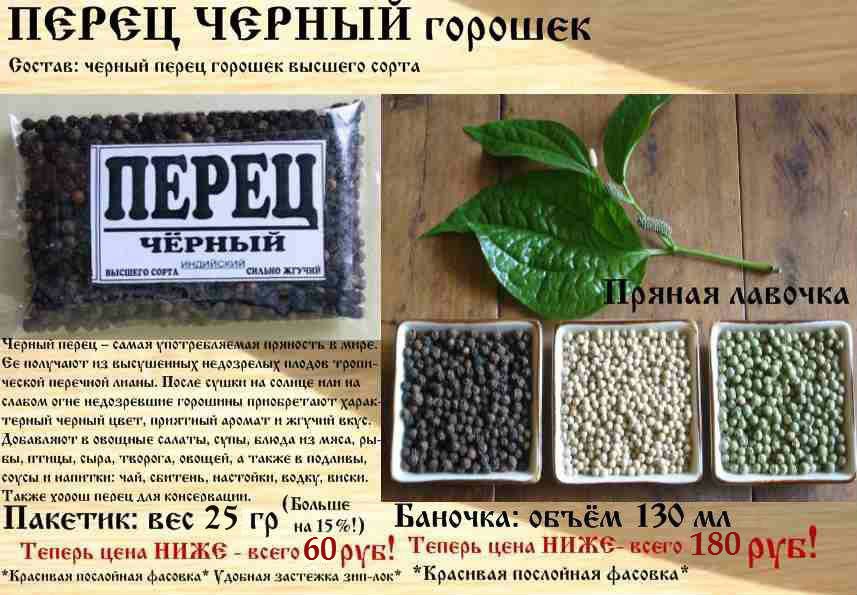
Black Pepper adds flavor to almost every food of every nation in the world. It is used in rubs, spice blends, salad dressings, and peppercorn blends. Pepper features prominently in several Arabic spice mixtures such as zhoug, baharat, and berebere. In Indian cooking, it is a component of garam masala and in France it is a main constituent of quatre épices (along with cloves, nutmeg, and dried ginger). In the United States, a combination of dried lemon and black pepper called “lemon pepper” is a popular seasoning for fish.
Cooking Tips
Black pepper is available whole, cracked, and ground but gourmet cooks prefer freshly ground peppercorns. Many savory dishes can be finished with freshly ground black pepper from a pepper mill. A coarse grind is desirable for dishes such as pepper-crusted steak. Larger amounts of peppercorns can be ground using a spice mill. The flavor of black pepper mellows with cooking. That is one reason why the pepper shaker on the table is so important. A dash of ground pepper, applied as each diner prefers, will perk up any cooked meal.
A dash of ground pepper, applied as each diner prefers, will perk up any cooked meal.
Black pepper is a staple in most American kitchens, but white pepper is more popular in French, Chinese, Vietamese, and Swedish cooking. Use care when substituting one for the other as the American palette is not always used to the stronger ‘musty’ type flavor typical of white pepper.
Did you know that pastry chefs in fine dining restaurants include black pepper in all kinds of desserts. It’s an especially delicious surprise in chocolate sweets, from fudge brownies, chocolate layer cake to chocolate truffles.
References
- “Pepper (Piper nigrum L.)”. Gernot Katzer’s Spice Pages. 2015. http://gernot-katzers-spice-pages.com/engl/Pipe_nig.html Retrieved 22 February 2021
- Zachariah, T. John, and V. A. Parthasarathy. “Black pepper.” Chemistry of spices 196 (2008): 21.
- “Global Pepper (piper spp.) production quantity in 2019; Crops/Regions/World Regions/Production Quantity (pick lists)”.
 UN Food and Agriculture Organization Corporate Statistical Database (FAOSTAT). 2019. http://www.fao.org/faostat/en/#data/QC Retrieved 22 February 2021.
UN Food and Agriculture Organization Corporate Statistical Database (FAOSTAT). 2019. http://www.fao.org/faostat/en/#data/QC Retrieved 22 February 2021. - Lawless, Lydia JR, Annette Hottenstein, and John Ellingsworth. “The McCormick spice wheel: a systematic and visual approach to sensory lexicon development.” Journal of sensory studies 27.1 (2012): 37-47.
Taste alphabet
Back to the list
Description and botanical characteristics
Black pepper (lat. Píper nígrum) is a perennial climbing plant, a species of the genus Pepper (Piper) of the Pepper family (Piperaceae). Liana up to 15 m long with aerial roots formed at the nodes. The leaves are simple, ovate, leathery, alternate, 8-100 mm long. The flowers are small, gray-yellow or white, collected in loose inflorescences 7-10 cm long.
The fruit is a rounded one-seeded drupe 3-5 mm in diameter, green, reddening when ripe, black when dried. Cobs 80 – 140 mm long contain 20 – 30 drupes.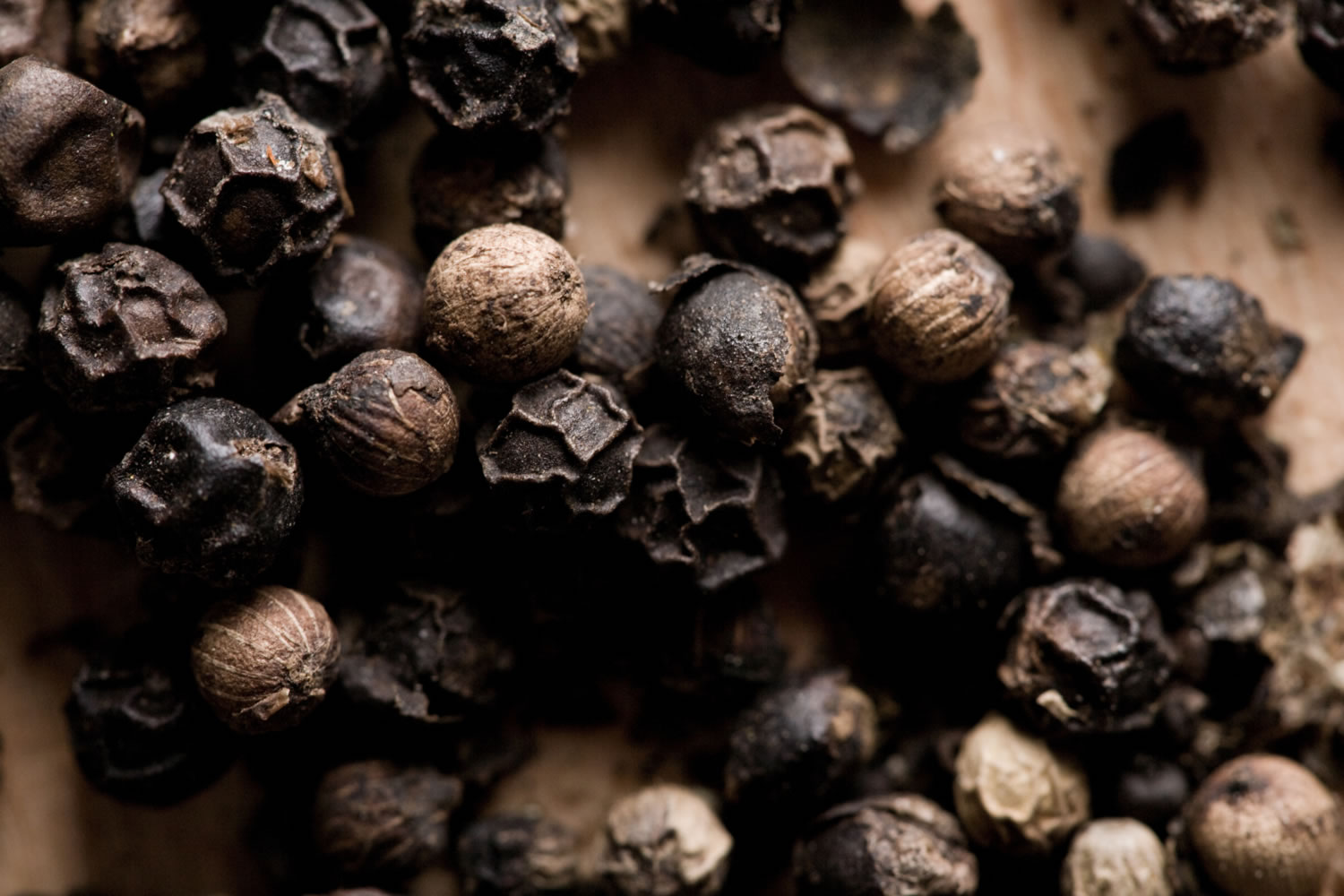 It bears fruit 2 times a year for 25 – 30 years.
It bears fruit 2 times a year for 25 – 30 years.
Unripe green fruits are used as a spice. They are dried in the sun or over low heat until they turn black and wrinkle. Peppers are sorted by size, separated from the stalks and packed. If the pericarp is not removed, then the hotness of the pepper increases.
Black pepper contains piperine (4.5 – 7.5%), piperidine, essential oil, starch, protein, vitamins.
Both whole peas and ground pepper are used. Keep in mind that whole peppers have a stronger flavor. Ground pepper quickly loses flavor, so grind it right before use.
Black pepper is sometimes also called the “Malabar berry” after its natural habitat – the Malabar Islands in southern India. In nature, the shrub wraps around trees, climbing up.
Since black pepper has become an agricultural crop, poles have been installed for it on plantations and this has limited its growth to a height of 4-5 m.
Black pepper is propagated by root shoots.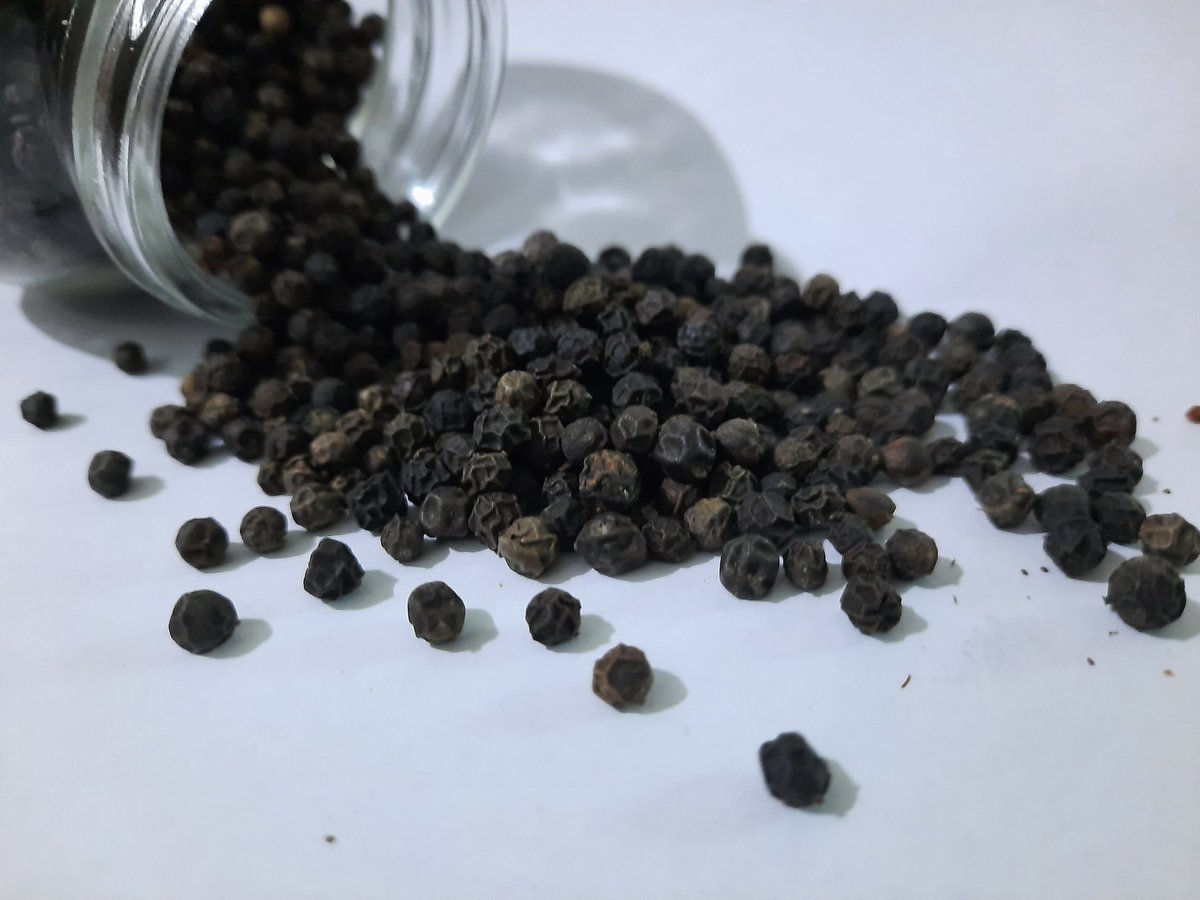 Harvesting is done in the third year. The fruits are harvested within a few months, as the ripening is uneven. Landings can be used for 15-20 years.
Harvesting is done in the third year. The fruits are harvested within a few months, as the ripening is uneven. Landings can be used for 15-20 years.
Origin and distribution
Black pepper is one of the oldest known spices and perhaps the most widely used in the world. It is mentioned in Sanskrit texts dating back to 1000 BC. It became one of the most important objects of trade between East and West. In ancient times, it happened that tribute, taxes and even dowry were paid with pepper.
Black pepper comes from the eastern shores of India, where it still grows as a wild jungle plant. It then made its way to Indonesia and other Southeast Asian countries. In Africa and America – only in the XX century. Black pepper was one of the reasons for the discovery of America and the appearance of red pepper. After all, it was for him and other Indian spices that Christopher Columbus equipped the expedition.
There are two main qualities of black pepper – its sharpness (due to piperine) and aroma (depending on the content of essential oils).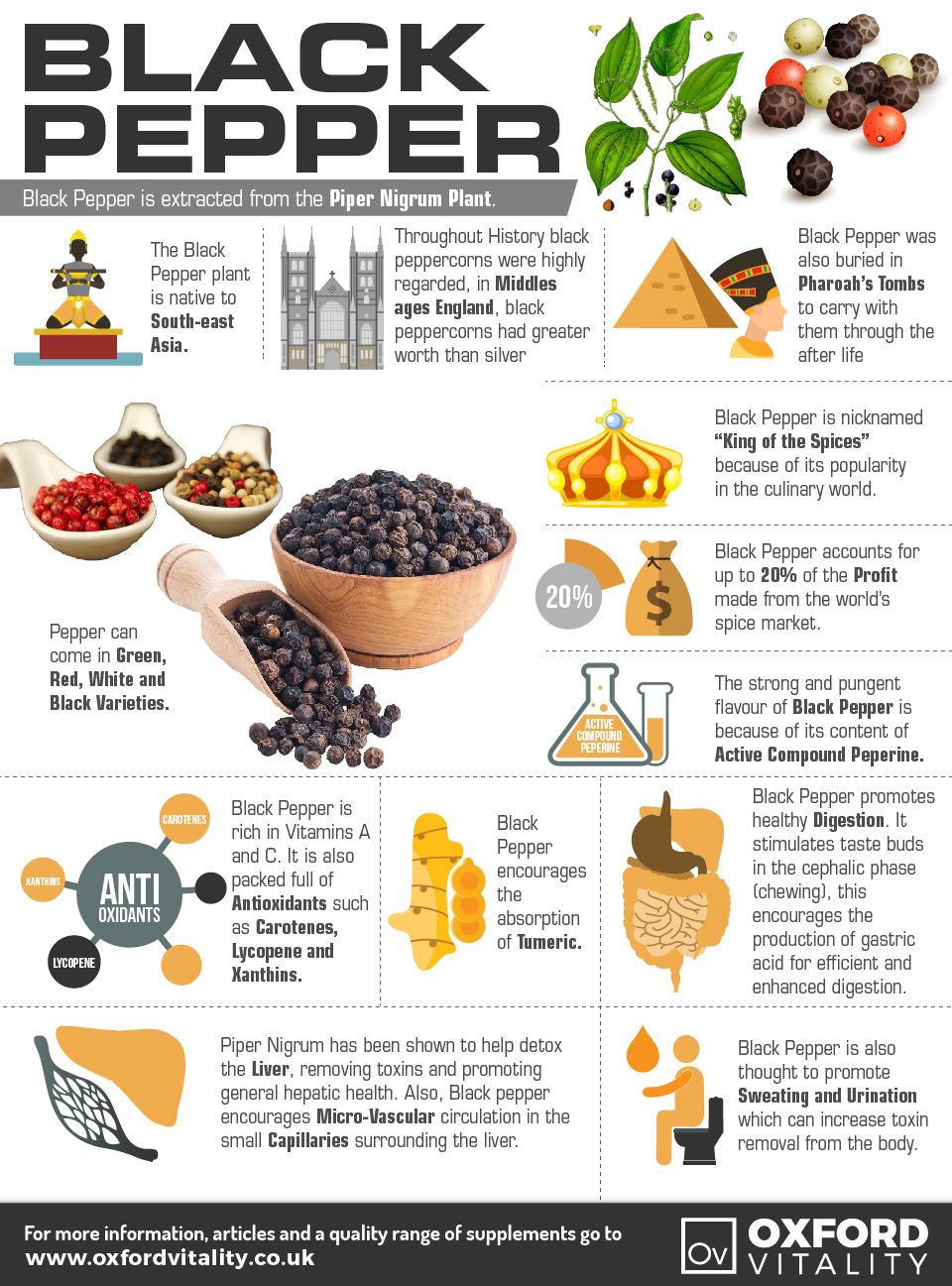 The most dense and heavy pepper of the highest quality from the Malabar coast of India is considered the best.
The most dense and heavy pepper of the highest quality from the Malabar coast of India is considered the best.
Currently, the largest black pepper producers are India, Indonesia and Brazil, which produce more than 40,000 tons of pepper per year.
The fruits of black pepper do not ripen at the same time, so the period of its collection is greatly extended. Ripening depends on the country of growth and on weather conditions. In Brazil, for example, they harvest twice a year: December/January and July/August.
Taste
Black pepper is the most widely used spice in the world. Any pepper has a sharp aroma. But the most striking aroma and taste – in black pepper. It is used in all branches of the food industry. Even in the confectionery industry, it is included in the composition of “dry perfumes”. Black pepper is part of most spice mixtures.
Black pepper is used in all kinds of dishes – even in desserts. So, in Latvia and Spain and India, some types of cookies are prepared with it.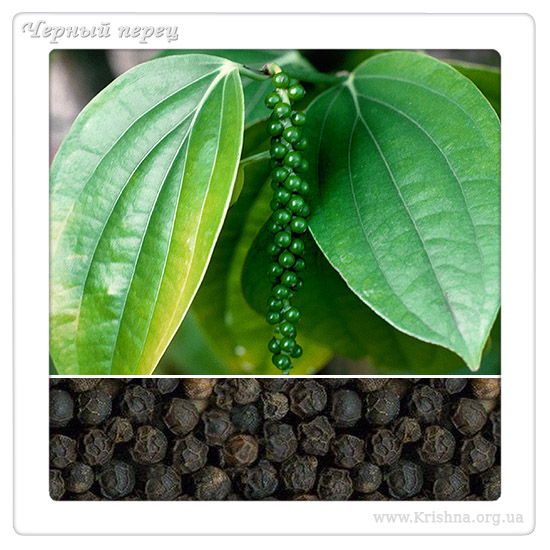 Black pepper can be found in old Russian gingerbread recipes. It is added to sbiten, tea, coffee, all kinds of cocktails.
Black pepper can be found in old Russian gingerbread recipes. It is added to sbiten, tea, coffee, all kinds of cocktails.
Hot soups will not have a rich spicy taste if they do not have a few black peppercorns in them at the beginning of cooking. Cold soups are most often seasoned with ground black pepper.
Ground black pepper is the best friend of salads. When pickling, urinating, fermenting, salting and other preservation, black pepper is indispensable for taste reasons, as well as due to the ability to increase the shelf life of blanks.
Patés, cheeses, sausages, aspic, jelly, rolls, all kinds of snacks – benefit from the presence of fragrant spicy pepper because black pepper stimulates the appetite.
Black pepper goes to hot dishes of beef, veal, pork, lamb, game, poultry, offal, fish, seafood.
Spice black pepper perfectly emphasizes the taste of eggs, dough, vegetables, mushrooms, cereals.
Black peppercorns can be stored for quite a long time (several years) if they remain black or dark brown in color.
Ground pepper does not like long heat treatment, unlike peas.
Beauty and health
Black pepper is a very useful spice for digestion: stimulates the appetite, promotes digestion, fights toxic substances, cleanses the body, improves immunity. Causes active sweating.
Black pepper is considered a germ fighter – it will protect the throat from colds and bronchitis, and is used in external preparations to treat inflammation. It is also used in dentistry to fight tooth decay and gum disease.
Black pepper has a stimulating effect, promotes concentration; improves blood circulation and the formation of red blood cells.
Black pepper is used to relax muscles, eliminate fatigue and sprains.
Black pepper is widely used in cosmetology – it improves and tones the skin, strengthens the hair.
Black pepper contains piperine, piperidine, essential oil, starch, protein. Peppers contain three times more vitamin C than oranges.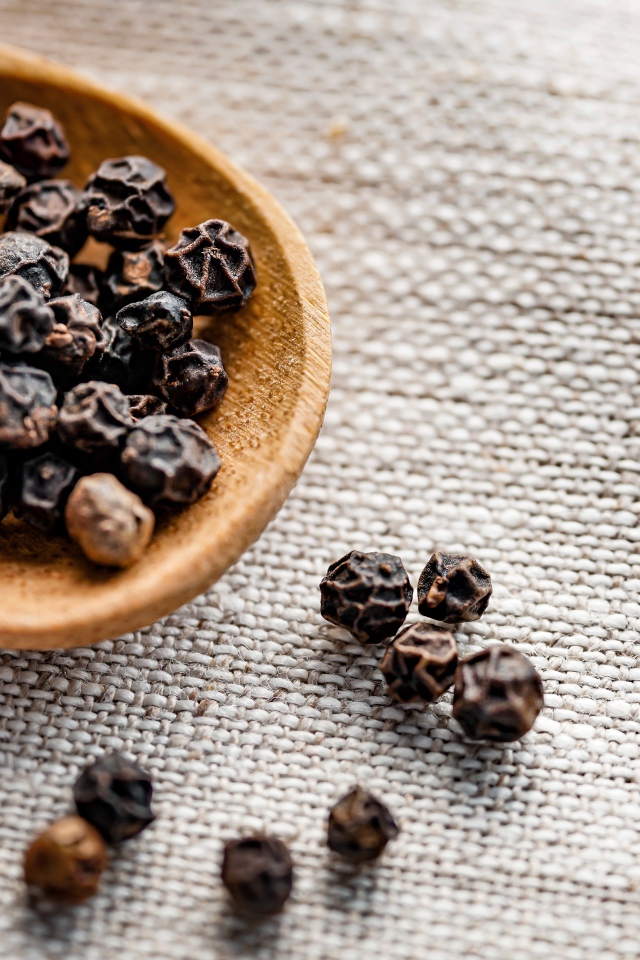 It is also rich in calcium, iron, phosphorus, carotene and B vitamins.
It is also rich in calcium, iron, phosphorus, carotene and B vitamins.
You can’t do without pepper in the kitchen. This spice is so common that in public catering establishments they put ground pepper in special pepper pots on tables in dining rooms. And any visitor can pepper the dish at his own discretion and taste.
How pepper has affected the world
Do you like spicy and hot? You are lucky that you were born in our time: black pepper, like many other spices, has long been an unaffordable luxury for most people. Why did it happen?
Four millennia ago, black pepper became popular in its homeland, India. It was used here not at all as a spice, but as a medicine: historians find recipes for potions from pepper in the ancient Indian medical texts Sushruta Samhita and Charaka Samhita.
The Malabar Coast in southwestern India has always been a great place to grow herbs and spices. Thanks to this place, black pepper received the name “Malabar berry” among other peoples. The Indians poured hot water on the berries and dried them in the sun for several days so that they would dry out and turn black.
Thanks to this place, black pepper received the name “Malabar berry” among other peoples. The Indians poured hot water on the berries and dried them in the sun for several days so that they would dry out and turn black.
Source: latinfood.about.com/od/recipesbyregion/tp/P
The amazing taste and medicinal properties contributed to the spread of pepper to Egypt: black peppercorns were discovered in the tomb of Ramses II (1213 BC). They were used in the mummification of the pharaoh.
The first of the peoples of the Ancient East who recognized black pepper were the Persians. But not everyone could afford to eat it: pepper was not grown anywhere except India, and transportation in those days was very costly and long. Pepper was so expensive that it was called black gold and used as a currency.
In Greece, pepper was also an expensive commodity that only the very rich could afford. This mysterious spice came to Europe during the time of Alexander the Great, who reached India in the 3rd century BC. BC. The Romans learn about black pepper from the Greeks and establish trade relations with India through the inhabitants of South Arabia. After in 30 BC. The Roman Empire conquered Egypt, the monopoly of Arab merchants on the spice trade was eliminated, and pepper became cheaper and more accessible. Pepper took pride of place in Roman cuisine, with most third-century cookbook recipes often featuring it as an ingredient.
BC. The Romans learn about black pepper from the Greeks and establish trade relations with India through the inhabitants of South Arabia. After in 30 BC. The Roman Empire conquered Egypt, the monopoly of Arab merchants on the spice trade was eliminated, and pepper became cheaper and more accessible. Pepper took pride of place in Roman cuisine, with most third-century cookbook recipes often featuring it as an ingredient.
But pepper still has not lost its value: in the 5th century, the Visigoths, besieging Rome, demanded and received a ransom, part of which was pepper. After the fall of the Great Empire, the spice market was again taken over, first by the Persians and then by the Arabs.
In the Middle Ages, black pepper was quite common in Europe. It served as a spice, a medicine, a coin of exchange, a means of investing capital, and just a gift. They were paid dues, bribes, fines. In Germany, wealthy people were called “pepper bags”. In London, in 1180, the Guild of Whole Pepper Merchants was created, which later became the Guild of Spice Merchants, a century later renamed the Grocers Company, which still exists today.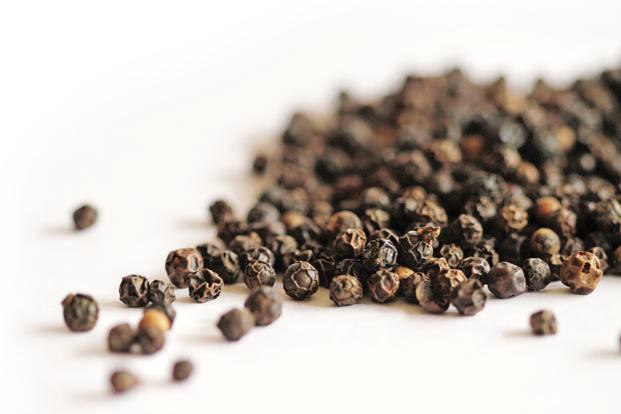
Source: scarletselkie.blogspot.ru/2014_09_01_archiv
The pepper trade was a very dangerous and even criminal business. Merchants were robbed, killed, and the merchants themselves often resorted to fraud. In France, when buying black pepper, you could buy a fake – a mixture of juniper, coriander and black pepper powders, which even had its own name – “La Rochelle”. The authorities of Western Europe resorted to severe punishments – in Germany, for example, such a merchant was buried alive.
Black pepper, like other spices of the East, has had a huge impact on the course of world history. The Malabar coast, the islands of Sumatra, Ceylon and Java, where pepper was grown, were the scene of bloody wars. Persians, Arabs, Portuguese and Dutch fought for the “land of pepper”. In Dutch, the word peperduur is still used to denote something very expensive.
Black pepper influenced geography, causing the Great Geographical Discoveries. Captain Ferdinand Magellan invited the Spanish king Charles the First to find a new way for the Spaniards to pepper – and thanks to his voyages and losses, it became known that the earth was round.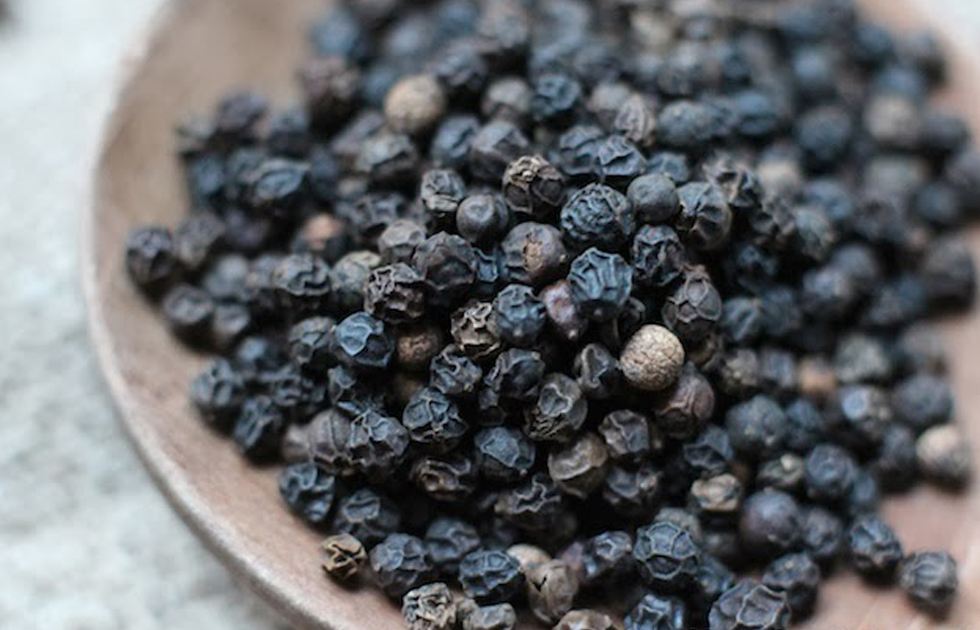 Round like a ball of pepper.
Round like a ball of pepper.
The discovery of America also happened due to the search for new routes to India.
Over time, pepper has been grown almost all over the world, but India, Indonesia and Brazil remain the largest producers of pepper. These countries produce over 40,000 tons of pepper per year. The first in the list of black pepper consumers are the USA, Russia, Germany, Japan and England. Pepper in our time is in any kitchen, and for those who like it spicier, a pepper pot is on every table in cafes and restaurants.
Pepper not only gives a piquant taste to meat and fish dishes, but also affects the digestive, circulatory, respiratory systems of a person, providing a tonic, expectorant, carminative, anthelmintic effect.
Studies show that pepper reduces the risk of cardiovascular disease: it thins the blood, destroys clots, and improves blood circulation. It also promotes digestion, stimulates the metabolic process, activating calorie burning. Peppers contain three times more vitamin C than oranges.

 Black pepper is most commonly used in
Black pepper is most commonly used in UN Food and Agriculture Organization Corporate Statistical Database (FAOSTAT). 2019. http://www.fao.org/faostat/en/#data/QC Retrieved 22 February 2021.
UN Food and Agriculture Organization Corporate Statistical Database (FAOSTAT). 2019. http://www.fao.org/faostat/en/#data/QC Retrieved 22 February 2021.